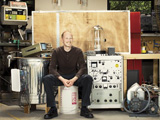|
|
TODAY.AZ / Weird / Interesting
What is that... A homemade scanning electron microscope?
03 August 2011 [12:17] - TODAY.AZ
 Ben Krasnow has built his share of odd contraptions, including a liquid nitrogen generator made from an air conditioner, and the “thirst extinguisher,” a commercial-grade fire extinguisher that cools, carbonates, and dispenses his homemade beer. Now, for no other reason than wanting a real challenge, the 28-year-old engineer picked the toughest DIY project he could imagine: a homemade scanning electron microscope, or SEM. “I wanted to see if it was possible,” he says.
Ben Krasnow has built his share of odd contraptions, including a liquid nitrogen generator made from an air conditioner, and the “thirst extinguisher,” a commercial-grade fire extinguisher that cools, carbonates, and dispenses his homemade beer. Now, for no other reason than wanting a real challenge, the 28-year-old engineer picked the toughest DIY project he could imagine: a homemade scanning electron microscope, or SEM. “I wanted to see if it was possible,” he says.Scientific labs will pay upward of $250,000 for a high-end SEM, and as far as Krasnow could find, no individual had ever built one, so he had to improvise. He first spent a few weeks teaching himself the complex physics behind the instrument. Next he trolled eBay for cheap components, sorted through his home shop for power sources that might work, and then built what he couldn’t find.
A typical SEM fires a thin stream of electrons at a sample, monitors the electrons kicked up by the impact, and translates the resulting signals into a picture.

Show Your Gold: The image of a necklace scanned by Krasnow’s microscope appears on the oscilloscope’s screen Courtesy Ben Krasnow
In his initial tests, Krasnow had trouble aiming the electron beam onto the sample. Eventually he took a refrigerator magnet and moved it around the outside of the glass vacuum chamber that surrounds the microscope to adjust the beam’s position. When he got the beam focused in the right place, he taped the magnet in place.
The microscope now delivers about 50x magnification, a far cry from commercial SEMs’ 1,000x or more, but microscope experts say that doesn’t lessen the accomplishment. Chemist Robert Wolkow of the University of Alberta calls it “a wonderful achievement.” And William Beaty, a research engineer and hobbyist who had also hoped to build the first DIY SEM, puts it more simply: “D’oh!”

Under Glass: The bell jar that houses the microscope’s component Cody Pickens
How It Works
Time: 100 hours
Cost: $1,500
Display
The SEM gets its name because the electron beam scans the surface of the sample; the resulting image is basically a video of a still subject. To create that video, Krasnow bought an old oscilloscope. As the beam moves across the surface, the clouds of electrons emitted from the sample change, and the oscilloscope transforms this physical data into a video image. The catch with the oscilloscope is that Krasnow scans the image in 1/15 of a second to get a picture, and quicker scans result in lower-resolution images. He plans to digitize the system and replace the oscilloscope with a computer, which should allow him to scan slowly and increase the microscope’s magnification.
Vacuum Cooling
To maintain the microscope’s thin beam of electrons, Krasnow had to eliminate any interference, so he housed the entire device in a large glass bell jar he had lying around. He used two separate pumps to create a vacuum inside the jar. One of the two has a tendency to overheat, so an aquarium pump sends engine coolant past the overheating pump, drawing out the heat, and cycles the fluid through a repurposed window-unit air conditioner, where it is cooled down before repeating the trip.
Retro Style
The oscilloscope and two of the power supplies look as if they could have been salvaged from a 1960s space mission. Krasnow liked the aesthetic, so he enclosed the power supplies in a similar-colored rack, arranged the other components above them, bought blank gray faceplates, drilled the necessary holes, and mounted chrome toggle switches, red indicator lights, knobs and gauges that matched the style.
/Popular Science/
URL: http://www.today.az/news/interesting/91954.html
 Print version
Print version
Views: 2178
Connect with us. Get latest news and updates.
See Also
- 19 February 2025 [22:20]
Visa and Mastercard can return to Russia, but with restrictions - 05 February 2025 [19:41]
Japan plans to negotiate with Trump to increase LNG imports from United States - 23 January 2025 [23:20]
Dubai once again named cleanest city in the world - 06 December 2024 [22:20]
Are scented candles harmful to health? - 23 November 2024 [14:11]
Magnitude 4.5 earthquake hits Azerbaijan's Lachin - 20 November 2024 [23:30]
Launch vehicle with prototype of Starship made its sixth test flight - 27 October 2024 [09:00]
Fuel prices expected to rise in Sweden - 24 October 2024 [19:14]
Turkiye strikes terror targets in Iraq and Syria - 23 October 2024 [23:46]
Kazakhstan supplied almost entire volume of oil planned for 2024 to Germany in 9 months - 23 October 2024 [22:17]
Taiwan reported passage of Chinese Navy aircraft carrier near island
Most Popular
 What von der Leyen doesn't know about. Or doesn't want to know
What von der Leyen doesn't know about. Or doesn't want to know
 Turkish auto sector shifts gears for green transformation
Turkish auto sector shifts gears for green transformation
 Bayramov: Direct talks yield better results than mediated dialogue
Bayramov: Direct talks yield better results than mediated dialogue
 Japan grants $3 billion loan to Ukraine using profits from frozen Russian assets
Japan grants $3 billion loan to Ukraine using profits from frozen Russian assets
 Baku spends over 1 billion manats on education in Q1
Baku spends over 1 billion manats on education in Q1
 America’s tariff strategy risks fragmenting global economy
America’s tariff strategy risks fragmenting global economy
 At least 148 dead after boat accident on DR Congo river
At least 148 dead after boat accident on DR Congo river
